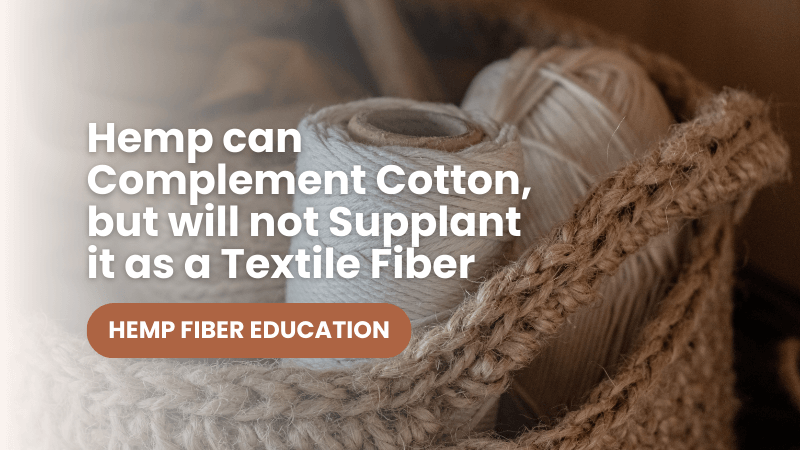Blog ► Hemp Can Compliment Cotton, But Will Not Supplant It
Hemp Can Compliment Cotton, but will Not Supplant it as a Textile FiberPosted: 08/04/22 | Author: Lawrence Serbin It has been suggested that hemp could supersede cotton in many aspects of the apparel industry. While hemp has some environmental advantages over cotton, its specific characteristics and behaviors as a cloth prevent it from completely replacing cotton fabrics. Learn more about hemp's sustainability at Hemp Traders. Environmental Benefits of HempHemp’s environmental benefits over cotton are well known. Hemp can produce more fiber per acre than cotton while requiring 20% less water. Hemp can be grown without pesticides or herbicides, while conventional cotton requires both insecticides and herbicides to cultivate. Learn more about hemp textile properties. Challenges of Processing HempHowever, hemp requires more processing to get the fibers into a form where they can be spun successfully into yarn. Cotton fibers exist individually in a cotton boll. Each fiber is separate from one another and more uniform in length and width compared with hemp. This makes it easier to spin cotton into yarn. Hemp bast fibers exist as a group in the bark, bonded by lignin, and need to be separated either by physically combing them or chemically removing the lignin in a process known as degumming. Learn more about hemp fabric production. Types of Hemp FibersApproximately 80% of hemp bast fibers are long, running the entire length of the stalks. These are referred to as line fiber. Shorter hemp fibers are referred to as tow. Degumming separates the hemp fibers, creating a mix of both long and short fibers. The long fibers of 4” - 6” are spun into yarn using flax spinning machines for 100% hemp fabrics, similar to linen. The shorter fibers of 1 1/8” to 2” long are blended with cotton and spun using cotton spinning machines to produce hemp/cotton blended yarns. Cottonizing HempIs it possible to convert hemp fibers into cotton fibers through a process known as cottonization? No. Cottonizing hemp does not mean turning hemp into a cotton-like fiber. It refers to shortening all the long hemp fibers to the same length as cotton, allowing them to be spun into yarns with cotton spinning machinery. It is better to make 100% hemp fabrics from the long fibers and blend the naturally occurring shorter fibers with cotton. If the fibers are all shortened and made into a 100% hemp fabric, the resulting material has a lower strength and quality compared to long fiber hemp. Unique Properties of Hemp and CottonBoth hemp and cotton have unique properties that make them better suited for different uses. Hemp is a stronger fiber requiring a greater amount of force to break. When a stronger and more durable fabric is required, hemp is the better choice. Hemp has a lower percent elongation compared to cotton, meaning when the fiber is pulled to its breaking point, hemp will not stretch before it breaks. This makes hemp the better choice for upholstery where the fabric needs to remain taut over the lifetime of furniture. Hemp is a hollow fiber, making it more water absorbent than cotton. Hemp fabrics hold dye better than cotton and are less likely to fade. The porous nature of the fibers contributes to better air circulation, resulting in greater breathability. The flow of air helps prevent the growth of anaerobic bacteria, reducing odor. In cold weather, the porous nature traps warm air, insulating the body. Advantages of CottonCotton does have some advantages over hemp. Cotton fibers are stretchy and tend to cling to one another, making it easier to spin them into yarns and create naturally stretchy knit fabrics like jersey and fleece. Cotton fibers are thinner and more uniform in size, allowing them to be spun into finer yarns. These yarns produce thinner, softer, and more tightly woven fabrics. Cotton fabrics shrink when washed and expand with use, providing snug fitting clothing like jeans. Clothing made of cotton will wrinkle less than hemp. Blending Hemp and CottonWhen hemp and cotton are blended together, both of their properties are incorporated into the fabrics. These two fibers complement one another rather than compete. These textiles are stronger, more absorbent than cotton fabrics, yet softer and less prone to wrinkling than hemp alone. By blending cotton with hemp and incorporating both of their attributes, we can reduce our reliance on petroleum-based synthetic fibers. |